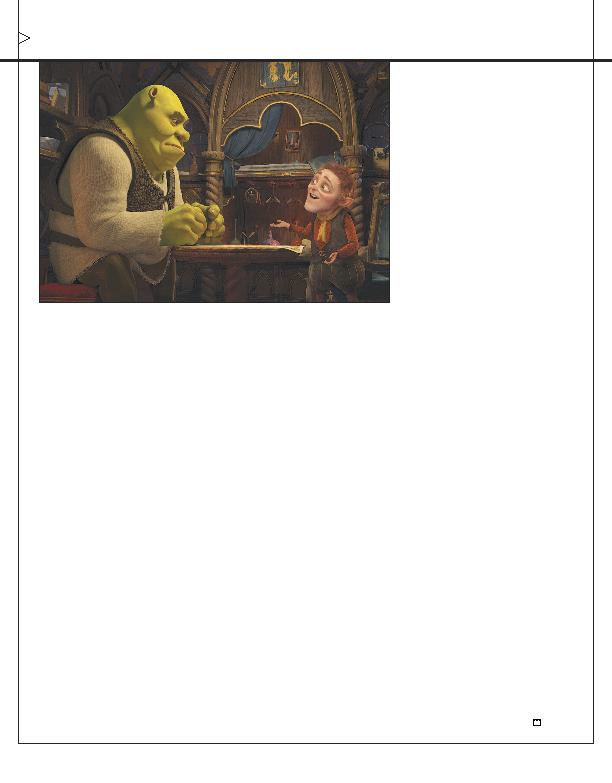
fourth, and final, installment of DreamWorks
Animation's legendary Shrek franchise, they
had the same thought: "What can you do with
another Shrek movie?" Once a feared and un-
kempt ogre, the character of Shrek had turned
into a loveable hero and, some would argue,
the subsequent sequels in the franchise suf-
fered because of this.
and craft a heartfelt father-son story. Klausner,
who was hired due to his rewrite work on
2007's Shrek the Third, at first wasn't enjoying
the assignment. "It was a little bit painful," he
admits. "It's always death for me when I know
the story before the movie has even started."
One element that was a constant this time
around was the studio's desire to use the popu-
lar fairy tale character Rumplestiltskin as the
film's villain. Eventually, after much discussion,
DreamWorks boss Jeffrey Katzenberg was con-
vinced that the movie's plot had to be altered.
spiration for a new story. "I'm a firm believer
that the best protagonists we can have are the
ones where we see them the way they see
have gone on, he's gone from feared to being
on lunchboxes," Lemke adds. "So the idea to
put Shrek in that same mindset was brilliant.
Villagers used to be scared of him; now they
want his autograph on their pitchforks." The
writers gave Shrek what they desired for him as
well: a return to the real ogre he used to be.
simple ogre again, if only briefly. He comes
across the mischievous Rumplestiltskin (Walt
Dohrn), who promises to grant him that wish.
As it turns out, the deal is actually a trick that
turns Far Far Away into a kingdom ruled by
Rumplestiltskin. In a case of "be careful what
you wish for," no one in Far Far Away knows
who Shrek is anymore, including his close
friends and wife, Fiona (Cameron Diaz).
feat for a franchise's fourth chapter. Lemke
and director Mike Mitchell came to describe
this as the Empire Strikes Back of the Shrek se-
ries, in that it is the darkest of all the films.
That reference came up often when the tone
was trying to be set. An example of this new
tone was a scene that centered on an argu-
ment between Shrek and Fiona. Penning a
comes cruel with one another was some-
thing that worried both writers.
tion was to play it a little safe." But it was
Katzenberg who kept pushing them to take it
further. "Lines are certainly crossed," Klausner
says, "but it's a good way to state that this is
different than the Shreks that came before."
Lemke adds, "For me, that scene became the
odometer for where we were allowed to go for
the whole movie."
is on the high end, copious rewriting is not un-
common on animated films. The script process
for animated movies involves writing a scene
and then storyboarding it with temporary di-
alogue. Once that sequence is screened, revi-
sions are done without a single frame of film
wasted. Neither Klausner nor Lemke has an ex-
tensive background in animation writing, so
this part of the process was a surprising, but
welcome, addition to their scripting. "It was
very liberating for me," Klausner explains.
"You get this instant gratification of being able
to watch your movie while you're editing. It's
an amazing process to go through as a writer
where you're able to easily discover what works
and what doesn't."
line and think, `This is the one!'" Lemke
laughs. "Then I'd realize that I wrote that same
line three months ago." The writers knew their
work was done not by how it read on the page,
but how it played out in the screening room.
"You know when you don't cringe in the
screening room," Klausner says. "It's when a
scene flows so smoothly that you don't even
notice when it's on to the next scene."
doing the puzzle in sequential order," he says.
Because of the storyboarding process, anima-
tion writing is more sequence-based. There are
no page-one rewrites here, but moreso the mas-
saging and re-crafting of certain scenes based
on their order in production. Though the
process differed greatly from feature-based writ-
ing, both writers relished their collective op-
portunity to work on the film. "Nine times out
of 10, as a feature writer, you're not going to be
on set to fix problems," Klausner says. "But with
animation, you're there. It was a real incredible
boot camp experience as a writer."